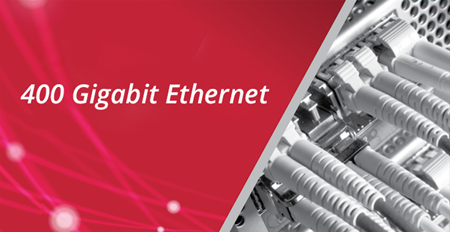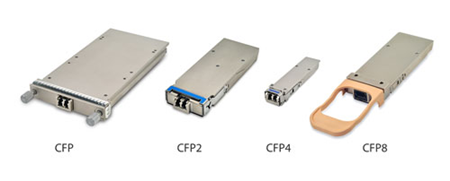The rapid development in telecom industry is driving massive demand for higher bandwidth and faster data rate, from 10G to 40G and 100G, will this keep going on? The answer is definitely “Yes”. Some time ago, migration from 10G to 40G or 25G to 100G has been a hot spot among data center managers. While recently, 400G solutions and 400G components are coming. Are you ready for 400G? This article will share some information about 400G Ethernet.
In the past couple of years, modules with four 25/28G lanes or wavelengths are the solutions for 100G Ethernet. However, they were expensive at the beginning. Until 2016, the optical components industry has responded to the demands with 100G solutions that already cost less per gigabit than equivalent 10G and 40G solutions, and new developments to further drive down cost and increase bandwidths. The next generation is 400G Ethernet. The IEEE has agreed on PSM4 with four parallel fibers for the 500 meters 400GBASE-DR4 specification that is part of the IEEE802.3bs standard being developed for approval by the end of 2017. The industry is already developing optical components for 400G Ethernet solutions. The following figure shows telecom and datacom adoption timelines.

We can visually see that telecom/enterprise applications first adopted 100G technology in the form of CFP modules. Data centers generally did not adopt 100G interfaces until the technology matured and evolved towards denser, lower power interfaces, particularly in the form of QSFP28 modules. However, as the hyperscale data center market scales to keep pace with machine-to-machine communications needs, data center operators have become the first to demand transmission modules for data rates of 400G and beyond. Therefore, the 400G era is now upon us.
We know that the QSFP28 modules for 100G Ethernet and SFP28 modules for 25G Ethernet are now the dominant form factors. Though CFP, CFP2 and CFP4 modules remain important for some applications, they have been eclipsed by QSFP28 modules. To support higher bandwidth, what is the right module for 400G? The first CFP8 modules are already available. QSFP-DD is backward compatible with QSFP, and OSFP may deliver better performance, especially as networks move to 800G interfaces.
CFP8 module: CFP8 module is the newest form factor under development by members of the CFP multisource agreement (MSA). It is approximately the size of CFP2 module. As for bandwidth density, it respectively supports eight times and four times the bandwidth density of CFP and CFP2 module. The interface of CFP8 module has been generally specified to allow for 16 x 25 Gb/s and 8 x 50 Gb/s mode.

QSFP-DD module: QSFP-DD refers to Quad Small Form Factor Pluggable Double Density. It uses eight 25G lanes via NRZ modulation or eight 50G lanes via PAM4 modulation, which can support optical link of 200 Gbps or 400 Gbps aggregate. In addition, QSFP-DD module can enable up to 14.4 Tbps aggregate bandwidth in a single switch slot. As it is backwards compatible with QSFP modules, QSFP-DD provides flexibility for end users and system designers.

OSFP module: OSFP (Octal Small Form Factor Pluggable) with eight high speed electrical lanes is able to support 400G (8x50G). It is slightly wider and deeper than the QSFP but it still supports 36 OSFP ports per 1U front panel, enabling 14.4 Tbps per 1U. The OSFP is able to meet the projected thermal requirements for 800 Gbps optics when those systems and optics become available in the future.

Judging from the current trends, 400G will become the mainstream in the near future. But there are still some challenges for it to overcome, such as high capacity density, low power consumption, ever lower cost per bit, and reliable large-scale manufacturing capabilities. You never know what surprise the network will bring to you, let’s wait and see the 400G’s time.




